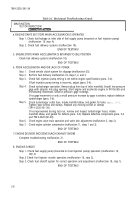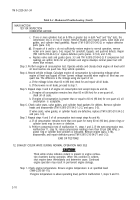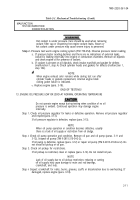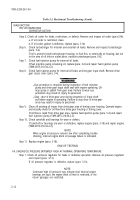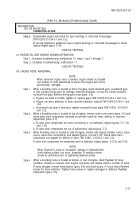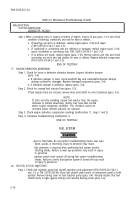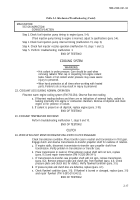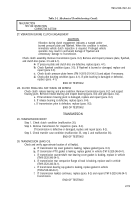TM-9-2320-361-34 - Page 33 of 764
TM9-2320-361-34
Table 2-1. Mechanical Troubleshooting (Contd).
MALFUNCTION
TEST OR INSPECTION
CORRECTIVE ACTION
25. BURNING ODOR EVIDENT WITH CLUTCH ENGAGED
Clutch engagement followed by a burning odor indicates clutch
improperly engaged and slipping. When this condition is evident,
inspection of vehicle clutch operation is required immediately.
Prolonged operation of vehicle under these conditions may result
in damaged clutch disc, pressure plate, and flywheel.
Clutch slippage due to improper clutch disc operation mav result
in damage to pressure plate, clutch disc, and flywheel contact
surface.
NOTE
Light surface discoloration of pressure plate and flywheel contact
surfaces may be removed with crocus cloth. Deeper discoloration
and hard spots on flywheel may require replacement of part.
Check clutch assembly condition. Remove transmission (para.
8-2).
Remove pressure plate and
clutch disc for inspection (para. 4-1). Remove release bearing for inspection (para. 8-4).
a. If flywheel or pressure plate surface is only slightly discolored or damaged, clean with
crocus cloth. If damage is greater, replace and repair (paras.
4-1
and 3-5).
b. If evidence of burned or hard spots on flywheel exist, replace (para. 3-5).
c. Clutch disc and release bearing defects require replacement of parts (paras. 8-4
and
4-1).
END OF TESTING!
26.
CLUTCH NOISY DURING ENGAGEMENT AND DISENGAGEMENT
Step 1. Check clutch noise. Place transmission in neutral. Start engine and push clutch pedal to
floor and release.
If noise increases when pedal is depressed and released, remove transmission (para. 8-2).
a. Check release bearing for defects (para. 8-4).
b. Check clutch pressure plate levers (TM 9-2815-210-34-2-2 and adjust if necessary).
Step 2. Place transmission in first gear, start engine, and engage clutch.
b.
c.
a
If clutch noise increased when engaged, remove transmission (para. 8-2).
Remove and inspect pressure plate and clutch disc for defects (para.
4-1).
If pressure plate or clutch disc are defective, replace (para. 4-1).
Check flywheel condition (para. 3-5).
If flywheel is burned or damaged, replace and repair (para. 3-5).
END OF TESTING!
2-18
Back to Top

